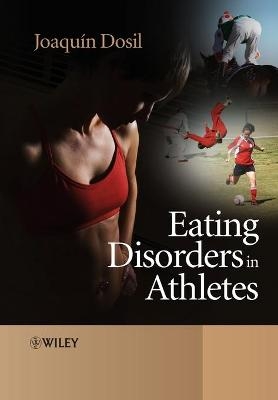
Eating Disorders in Athletes
Wiley-Interscience (Verlag)
978-0-470-01170-6 (ISBN)
- Lieferbar (Termin unbekannt)
- Versandkostenfrei
- Auch auf Rechnung
- Artikel merken
Joaquin Dosil, PhD, is a professor at the Univesity of Vigo in north-west Spain and head of the doctoral course: 'Current perspectives of physical activity and sport psychology'. He is a foundation member and the former President of the Ibero-American Society of Sport Psychology (SIPD). Dosil is the Director of a Sport Psychology Unit in Santiago de Compostela, where he attends athletes and sport teams from various modalities and levels. He has authored or edited 12 books with the most recent being. The Sport Psychologist's Handbook: A guide for Sport-Specific Performance Enhancement, and published over 60 articles and chapters in Spanish. He frequently participates as a lecturer in International and National Congresses, Masters and Doctoral Degree programmes. Dosil is also an avid runner, specializing in distance events, particularly the half-marathon.
Foreword by Mark Andersen ix
List of Contributors xiii
Introduction xv
1 Good eating habits in sport 1
1.1 Introduction 1
1.2 Balanced diet in sport 2
1.2.1 What is a balanced diet? 2
1.2.2 Energy requirements 3
1.2.3 Elaborating a nutritional plan 4
1.3 Nutrients required by humans and athletes 5
1.3.1 Macronutrients 6
1.3.2 Micronutrients 12
1.3.3 Water 15
1.4 The need for ergogenic aids 17
1.5 Nutritional information for athletes 19
1.6 Conclusions 21
2 The importance of weight in some sports 23
2.1 Introduction 24
2.2 High-risk sports 24
2.3 Weight-loss methods in sport 28
2.4 The difference between 'real weight', 'ideal weight' and 'sports weight' 33
2.4.1 Ideal weight vs. real weight 34
2.4.2 Real weight vs. sports weight 37
2.4.3 Ideal weight vs. sports weight 39
2.5 Conclusions 40
3 Eating disorders and the athlete's environment 41
3.1 Introduction 42
3.2 Pressures in the athlete's environment 43
3.2.1 The role of the family 47
3.2.2 The role of the coach 50
3.2.3 The role of the team-mates 53
3.3 The prevention of eating disorders in sport 55
3.4 Eating disorders prevention programmes for athletes 57
3.5 Conclusions 62
4 Diagnosis and assessment of eating disorders in sport 65
4.1 Introduction 65
4.2 Diagnostic criteria for eating disorders in sport 67
4.2.1 Anorexia in sport 68
4.2.2 Bulimia in sport 72
4.2.3 Bigorexia and orthorexia 74
4.2.4 Eating disorders not otherwise specifi ed (EDNOS) 78
4.3 Methods for diagnosing eating disorders in sport 79
4.3.1 Interviews 79
4.3.2 The assessment of body weight: anthropometrical indices 82
4.3.3 Body image perception: dissatisfaction and disturbance 83
4.3.4 The female athlete triad 84
4.3.5 Observation 87
4.3.6 Questionnaires 90
4.4 Conclusions 96
5 Eating disorders in different sports 99
5.1 Introduction 99
5.2 The aetiology of eating disorders in sport 100
5.3 Research into eating disorders in 'high-risk' sports 102
5.3.1 Aesthetic sports: gymnastics, figure/ice skating and ballet dancing 102
5.3.2 Weight division sports: judo, wrestling and rowing 106
5.3.3 Gym sports: aerobics and bodybuilding 111
5.3.4 Endurance sports and disciplines requiring low weight for high performance: athletics, swimming, and horser acing 113
5.4 Eating disorders symptoms: the sporting discipline and gender 116
5.4.1 The influence of the sporting discipline 117
5.4.2 The influence of gender 119
5.5 Conclusions 121
6 Treating eating disorders in sport 123
6.1 Introduction 123
6.2 The treatment regime 124
6.3 The treatment steps 125
6.3.1 Developing the motivation to change 125
6.3.2 Treatment objectives 127
6.3.3 Techniques and methods used in the treatment of eating disorders 132
6.3.4 Sequencing treatment 134
6.4 Types of treatment 140
6.4.1 Individual treatment 140
6.4.2 Family and/or couple therapy 142
6.4.3 Group therapy 142
6.4.4 Pharmaceutical therapy 142
6.5 Conclusions 143
7 Cyberpsychology and eating disorders in sport 145
7.1 Introduction 145
7.2 Psychology and new technologies: cyberpsychology 146
7.3 Cyber-sport-psychology and eating disorders 148
7.4 The Internet: information about eating disorders in sport 149
7.5 On-line diagnosis and treatment of eating disorders in sport 153
7.5.1 Commencing on-line treatment of an eating disorder in sport 155
7.5.2 Contact with professionals 157
7.5.3 The initial assessment 159
7.5.4 The objectives of on-line therapy 160
7.5.5 On-line sessions 161
7.5.6 The sports psychologist and on-line treatment 162
7.5.7 Paying for on-line sessions 164
7.5.8 The advantages and disadvantages of using on-line therapy to treat eating disorders in sport 164
7.6 Conclusions 167
8 Case studies in high-risk sports 169
8.1 Introduction 169
8.2 A case study of eating disorders in athletics 170
8.2.1 Case description 170
8.2.2 Analysis of the situation 171
8.2.3 Treatment and follow-up 172
8.3 A case of eating disorders in taekwondo 176
8.3.1 Case description 177
8.3.2 Analysis of the situation 177
8.3.3 'Urgent' treatment 178
8.4 A case of eating disorders in gymnastics 179
8.4.1 Case description 179
8.4.2 Analysis of the situation 180
8.4.3 Treatment 180
8.5 A case of eating disorders in aerobics 181
8.5.1 Case description 181
8.5.2 Analysis of the situation 182
8.5.3 Treatment 182
8.6 Sport: a solution to combat anorexia 183
8.6.1 Case description 184
8.6.2 Treatment 184
8.7 Conclusions 185
References 187
Index 205
| Erscheint lt. Verlag | 1.3.2008 |
|---|---|
| Sprache | englisch |
| Maße | 170 x 244 mm |
| Gewicht | 408 g |
| Themenwelt | Medizin / Pharmazie ► Medizinische Fachgebiete ► Psychosomatik |
| Medizin / Pharmazie ► Medizinische Fachgebiete ► Psychiatrie / Psychotherapie | |
| Medizin / Pharmazie ► Medizinische Fachgebiete ► Sportmedizin | |
| Naturwissenschaften ► Biologie | |
| ISBN-10 | 0-470-01170-X / 047001170X |
| ISBN-13 | 978-0-470-01170-6 / 9780470011706 |
| Zustand | Neuware |
| Haben Sie eine Frage zum Produkt? |
aus dem Bereich


